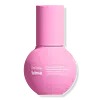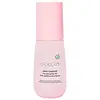What's inside
What's inside
 Key Ingredients
Key Ingredients

 Benefits
Benefits

 Concerns
Concerns

 Ingredients Side-by-side
Ingredients Side-by-side

Dimethicone
EmollientIsopropyl Myristate
EmollientPhenyl Trimethicone
Skin ConditioningIsododecane
EmollientC13-15 Alkane
SolventNeopentyl Glycol Diheptanoate
EmollientArgania Spinosa Kernel Oil
EmollientVitis Vinifera Seed Oil
EmollientRosa Rubiginosa Seed Oil
EmollientTocopherol
AntioxidantParfum
MaskingGeraniol
PerfumingCoumarin
PerfumingRose Ketone-4
PerfumingTetramethyl Acetyloctahydronaphthalenes
MaskingDimethicone
EmollientNeopentyl Glycol Diheptanoate
EmollientIsododecane
EmollientParfum
MaskingDimethicone Crosspolymer
Emulsion StabilisingTocopherol
AntioxidantBrassica Campestris/Aleurites Fordi Oil Copolymer
Skin ConditioningEthylhexyl Olivate
Skin ConditioningSqualane
EmollientBenzyl Salicylate
PerfumingCitral
PerfumingCitronellol
PerfumingCitrus Aurantium Peel Oil
Citrus Limon Peel Oil
MaskingGeraniol
PerfumingGeranyl Acetate
PerfumingLimonene
PerfumingLinalool
PerfumingLinalyl Acetate
MaskingPinene
MaskingRose Ketone-4
PerfumingTetramethyl Acetyloctahydronaphthalenes
MaskingTrimethylbenzenepropanol
Masking3-Methyl-5-(2,2,3-Trimethyl-3-Cyclopentenyl)Pent-4-En-2-Ol
PerfumingVanillin
MaskingDimethicone, Neopentyl Glycol Diheptanoate, Isododecane, Parfum, Dimethicone Crosspolymer, Tocopherol, Brassica Campestris/Aleurites Fordi Oil Copolymer, Ethylhexyl Olivate, Squalane, Benzyl Salicylate, Citral, Citronellol, Citrus Aurantium Peel Oil, Citrus Limon Peel Oil, Geraniol, Geranyl Acetate, Limonene, Linalool, Linalyl Acetate, Pinene, Rose Ketone-4, Tetramethyl Acetyloctahydronaphthalenes, Trimethylbenzenepropanol, 3-Methyl-5-(2,2,3-Trimethyl-3-Cyclopentenyl)Pent-4-En-2-Ol, Vanillin
Ingredients Explained
These ingredients are found in both products.
Ingredients higher up in an ingredient list are typically present in a larger amount.
Dimethicone is a type of synthetic silicone created from natural materials such as quartz.
What it does:
Dimethicone comes in different viscosities:
Depending on the viscosity, dimethicone has different properties.
Ingredients lists don't always show which type is used, so we recommend reaching out to the brand if you have questions about the viscosity.
This ingredient is unlikely to cause irritation because it does not get absorbed into skin. However, people with silicone allergies should be careful about using this ingredient.
Note: Dimethicone may contribute to pilling. This is because it is not oil or water soluble, so pilling may occur when layered with products. When mixed with heavy oils in a formula, the outcome is also quite greasy.
Learn more about DimethiconeGeraniol is used to add fragrance/parfum to a product. It is the main component of citronellol. It is a monoterpenoid and an alcohol.
Monoterpenes are naturally found in many parts of different plants.
Geraniol can be found in many essential oils including Rose Oil and Citronella Oil. The scent of Geraniol is often described as "rose-like". Many foods also contain Geraniol for fruit flavoring.
Geraniol can irritate the skin when exposed to air. However, irritation depends on the ability of geraniol to penetrate into the skin. In general, geraniol is not able to penetrate skin easily.
Geraniol is colorless and has low water-solubility. However, it is soluble in common organic solvents.
Like citronellol, it is a natural insect repellent.
2,6-Octadien-1-ol, 3,7-dimethyl-, (2E)-
Learn more about GeraniolIsododecane is a fragrance, emollient, and solvent.
As an emollient, it helps your skin stay soft and hydrated. Emollients help trap moisture into your skin.
Isododecane's role as a solvent makes it a great texture enhancer. It spreads smoothly on skin and does not leave a sticky feeling behind. Isododecane also helps prevent color transfer in makeup products.
Isododecane is not absorbed into skin.
Learn more about IsododecaneWe don't have a description for Neopentyl Glycol Diheptanoate yet.
Parfum is a catch-all term for an ingredient or more that is used to give a scent to products.
Also called "fragrance", this ingredient can be a blend of hundreds of chemicals or plant oils. This means every product with "fragrance" or "parfum" in the ingredients list is a different mixture.
For instance, Habanolide is a proprietary trade name for a specific aroma chemical. When used as a fragrance ingredient in cosmetics, most aroma chemicals fall under the broad labeling category of “FRAGRANCE” or “PARFUM” according to EU and US regulations.
The term 'parfum' or 'fragrance' is not regulated in many countries. In many cases, it is up to the brand to define this term.
For instance, many brands choose to label themselves as "fragrance-free" because they are not using synthetic fragrances. However, their products may still contain ingredients such as essential oils that are considered a fragrance by INCI standards.
One example is Calendula flower extract. Calendula is an essential oil that still imparts a scent or 'fragrance'.
Depending on the blend, the ingredients in the mixture can cause allergies and sensitivities on the skin. Some ingredients that are known EU allergens include linalool and citronellol.
Parfum can also be used to mask or cover an unpleasant scent.
The bottom line is: not all fragrances/parfum/ingredients are created equally. If you are worried about fragrances, we recommend taking a closer look at an ingredient. And of course, we always recommend speaking with a professional.
Learn more about ParfumRose Ketone-4 is a fragrance.
This ingredient is also known as ISO E Super. It is a synthetic perfuming and masking ingredient.
The manufacturer describes this scnet as amber and woody.
According to the EU, this ingredient is a known allergen and some people may develop skin sensitivity from repeated exposure.
Learn more about Tetramethyl AcetyloctahydronaphthalenesTocopherol (also known as Vitamin E) is a common antioxidant used to help protect the skin from free-radicals and strengthen the skin barrier. It's also fat soluble - this means our skin is great at absorbing it.
Vitamin E also helps keep your natural skin lipids healthy. Your lipid skin barrier naturally consists of lipids, ceramides, and fatty acids. Vitamin E offers extra protection for your skin’s lipid barrier, keeping your skin healthy and nourished.
Another benefit is a bit of UV protection. Vitamin E helps reduce the damage caused by UVB rays. (It should not replace your sunscreen). Combining it with Vitamin C can decrease sunburned cells and hyperpigmentation after UV exposure.
You might have noticed Vitamin E + C often paired together. This is because it is great at stabilizing Vitamin C. Using the two together helps increase the effectiveness of both ingredients.
There are often claims that Vitamin E can reduce/prevent scarring, but these claims haven't been confirmed by scientific research.
Learn more about Tocopherol